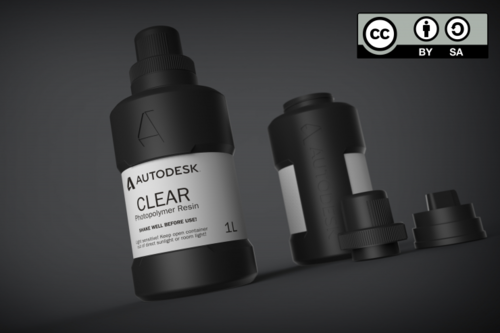
Yesterday, Autodesk announced that it was open sourcing one of the resins for its spark 3D printer. Autodesk says that they are releasing the recipe under a Creative Commons attribution-share alike license, and invited the community to remix, improve, and build upon it as they saw fit. This decision is commendable on the part of Autodesk, but what does it actually mean to open source 3D printing resin?
Open source can mean a lot of things to a lot of people, but generally speaking it usually involves (at least) two elements. The first is releasing documentation for the thing being open sourced in a way that allows people to understand how it works and really begin to access it. The second is licensing any intellectual property rights connected to the thing being open sourced in a way that allows sharing, remixing, and building upon.
Autodesk’s announcement appears to fulfill that first requirement quite well: they released the ingredient list of the resin. This should allow people outside of Autodesk to accurately reproduce the resin, which is the first step to building up on it.
The second requirement is a bit more complicated. The language in the announcement blog post makes it clear that Autodesk’s intention is to invite people to use and improve the resin as they see fit. And the use of the Creative Commons license is a signal about how Autodesk would like people to use the resin.
But is that license really necessary? Licenses are important in the context of open source software because software is automatically protected by copyright. Software’s default state is protected, and the creator of software needs to take affirmative steps in order to allow other people to remix and build upon their work.
Resin is different. Resin, and a formula for resin, is not protected by copyright. Unless Autodesk decided to patent its resin, that resin is “open” by default. No one needs permission from Autodesk to copy or improve upon their resin, or to reproduce its core formula. In that sense, Autodesk’s Creative Commons license on the formula is legally meaningless.
Autodesk is a big company with a lot of lawyers, and those lawyers undoubtedly understand that the licenses here are largely symbolic. That can be ok, because even when licenses aren’t legally binding, they can serve as important signaling devices to users (when getting close to a big company with lots of lawyers, wanting a belt and suspenders rights clearance guarantee isn’t crazy).
But as the world of open source expands beyond software, it is important to take time to remember that translating the open source spirit to non-copyrightable things isn’t as simple as transferring existing licenses. Among many other things, that means remembering that the absence of a license doesn’t mean something is closed, and that the presence of a license doesn’t necessarily give you any permissions that you didn’t have already.
None of this takes anything away from Autodesk today. If this is what it means for them to “think differently about 3D printing” it should be welcomed and cheered. But that doesn’t make it any less important to pay close attention to what, exactly, they are doing.
Image credit: Autodesk